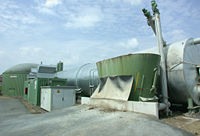
Photo from wikipedia
Even though biomass gasification remains a promising technology regarding de-centralized sustainable energy supply, its main limitations, namely the issues of unsteady operation, tar formation in after-treatment systems, and consequential high… Click to show full abstract
Even though biomass gasification remains a promising technology regarding de-centralized sustainable energy supply, its main limitations, namely the issues of unsteady operation, tar formation in after-treatment systems, and consequential high maintenance requirements, have never been fully overcome. In order to tackle the latter two deficiencies and to increase the understanding of thermodynamic and thermokinetic producer gas phase phenomena within the after-treatment zones, a numerical system dynamic model has been created. Thereby, naphthalene has been chosen to represent the behavior of tars. The model has been validated against a wide variety of measured and simulated producer gas compositions. This work particularly focuses on the investigation and minimization of tar formation within after-treatment systems at low pressures and decreasing temperatures. Model-based analysis has led to a range of recommended measures, which could reduce the formation tendency and thus the condensation of tars in those zones. These recommendations are (i) to decrease gas residence time within pipes and producer gas purification devices, (ii) to increase temperatures in low-pressure zones, (iii) to increase hydrogen to carbon ratio, and (iv) to increase oxygen to carbon ratio in the producer gas. Furthermore, the numerical model has been included in the cloud-computing platform KaleidoSim. Thus, a wider range of process parameter combinations could be investigated in reasonable time. Consequentially, a simulation-based sensitivity analysis of producer gas composition with respect to process parameter changes was conducted and the validity basis of the above recommendations was enlarged.
Journal Title: Biomass Conversion and Biorefinery
Year Published: 2020
Link to full text (if available)
Share on Social Media: Sign Up to like & get
recommendations!